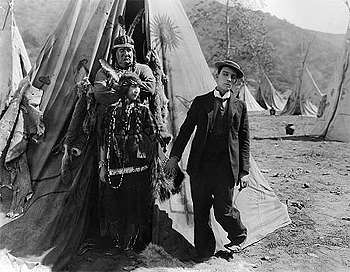The Paleface (1922 film)

"Kill first white man that comes in that gate."—title card immediately before the entrance of Guess Who
In this 1921 short, lepidopterist Buster Keaton is inducted into an Indian tribe and saves their land from the corrupt oilmen who stole their lease.
Not to be confused with the 1948 Bob Hope movie.
The Paleface can be seen on multiple pages on YouTube, like this one.
Tropes used in The Paleface (1922 film) include:
- Absent-Minded Professor
- An Axe to Grind
- Babies Ever After: Subverted. That would seem to be the obvious payoff to a title card that follows a kiss and reads, "Two years later," but instead it shows Buster and his girl still in their clinch.
- Bound and Gagged: Just the first part.
- Burn the Witch: Or in this case, the first white man to dare show his face.
- Chase Scene
- The Chief's Daughter
- Clothing Damage
- Corrupt Corporate Executive
- Dodgy Toupee
- The Door Slams You: Variation -- the door is forced off its hinges and Buster is trapped beneath it.
- Dressing as the Enemy
- Fake Nationality: Whites playing Native Americans.
- Fan Service: Buster's bare arms as he makes the asbestos suit.
- Fireman's Safety Net: Improvised with an Indian blanket.
- Flaying Alive: Subverted with the Dodgy Toupee.
- Friend or Foe
- Improvised Parachute
- Injun Country
- Mighty Whitey
- Nice Hat: Buster accessorizes his trademark hat with an eagle's feather. The chief villain wears a silk top hat.
- No Escape but Down
- Out of the Inferno: Courtesy of the asbestos suit.
- Rope Bridge
- Soft Water
- Standard Hero Reward
- Tap on the Head
This article is issued from Allthetropes. The text is licensed under Creative Commons - Attribution - Sharealike. Additional terms may apply for the media files.